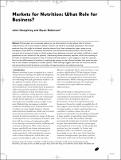| dc.contributor.author | Humphrey, John | en |
| dc.contributor.author | Robinson, Ewan | en |
| dc.date.accessioned | 2016-01-11T13:18:14Z | |
| dc.date.available | 2016-01-11T13:18:14Z | |
| dc.date.issued | 01/05/2015 | en |
| dc.identifier.citation | Humphrey, J. and Robinson, E. (2015) Markets for Nutrition: What Role for Business?. IDS Bulletin 46(3): 59-69 | en |
| dc.identifier.issn | 1759-5436 | en |
| dc.identifier.uri | https://opendocs.ids.ac.uk/opendocs/handle/20.500.12413/7719 | |
| dc.description.abstract | Policymakers are increasingly seeking to use food systems to help reduce rates of chronic undernutrition and to use markets to deliver nutrient?rich foods to vulnerable populations. This article examines how this might be achieved, drawing lessons from three intervention types: ready?to?use therapeutic foods (RUTFs), mandatory fortification and voluntarily fortified products. We find that a common set of constraints tends to inhibit markets from delivering nutrition and makes it difficult to reach populations at the ‘bottom of the pyramid’. Overcoming these constraints requires a shift from working at the level of individual businesses to that of market and food systems. It also suggests a need for renewed focus on the effectiveness of products in reaching key groups, on the informal markets that serve the poor and on the inherent complexity of market systems. These findings suggest that food and nutrition policies and partnerships should be based on principles of experimentation and adaptive learning. | en |
| dc.format.extent | 11 | en |
| dc.publisher | © 2015 Institute of Development Studies | en |
| dc.relation.ispartofseries | IDS Bulletin Vol. 46 Nos. 3 | en |
| dc.rights.uri | http://www.ids.ac.uk/files/dmfile/IDSOpenDocsStandardTermsOfUse.pdf | en |
| dc.title | Markets for Nutrition: What Role for Business? | en |
| dc.type | Article | en |
| dc.identifier.doi | 10.1111/1759-5436.12144 | en |

